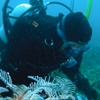General Description
Colony of individual polyps (hydranths) joined by root-like network of tubular stolons at the base. Colony shape is lacy. Colour: colonies dirty white, stems in older colonies brownish; medusae transparent white, stomach often golden brown. Often more than 6 cm long.
Biology
Colonies of this common southern Australian species grow and mature in winter.
Habitat
On hard surfaces and invertebrates in shallow water, often on jetty pylons.
Reefs
Distribution guide
Temperate waters worldwide. In southern Australia.
Species Group
Depth
Water Column
Max Size
6 cm
Diet
Plankton or Particles
Harmful
Generally not harmful but still able to sting bare skin.
Commercial Species
No
Global Dispersal
Recorded in Australia
Identify
Conservation Status
- DSE Advisory List : Not listed
- EPBC Act 1999 : Not listed
- IUCN Red List : Not listed






